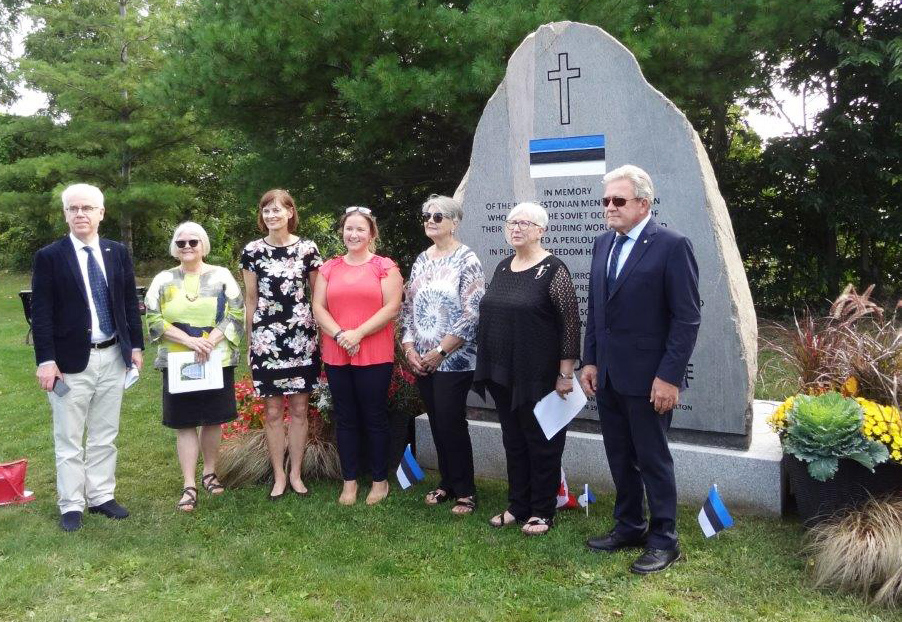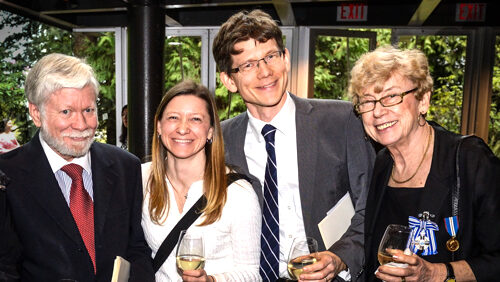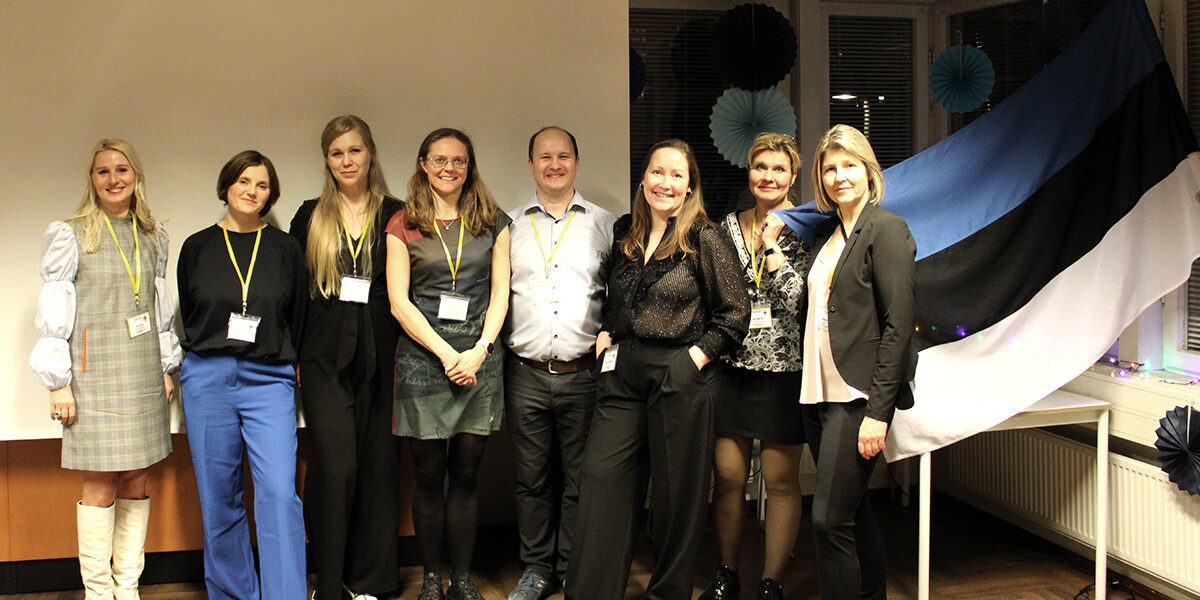
The First Estonian Evangelical Lutheran Church Congregation in Hamilton has been the initiator and implementer for the memorial monument. The initial idea of a commemorative and lasting feature to recognize the local area Estonian refugees came from Jaan Pallop, the chairman of the congregation's council. Mr. Pallop is himself one of those refugees (being only one year old at the time) and whose family desperately boarded a refugee ship at the port of Tallinn in September 1944 in order to flee the invading Soviet Red Army.
The planning, design, funding and implementation of the monument has been both a challenging and rewarding “team” project for the church council. The council also thanks Ivar Rammo, a longtime active member of the Hamilton Estonian community, for formulating the basis of the phrases engraved on the monument.
The commemoration ceremony for the memorial monument took place at Burlington's Woodland Cemetery, where the monument is prominently situated on a high bluff overlooking Burlington Bay and Hamilton harbour. The backdrop of pine trees, deciduous trees and the large bay are all natural elements that Estonia is also known for – this aspect was a key consideration in choosing the site for the monument. Many of the local Estonian refugees who made the Hamilton area their new home are buried in this cemetery.
“Throughout history, rocks have come to symbolize strength, endurance, perseverance and the resiliency of the human spirit…”
Merike Koger, who is well known for her active participation in many of the local Estonian diaspora organizations and events and who is a member of the congregation council, was the MC for the ceremony. After the singing of O Canada, Ms. Koger introduced the event program with her opening remarks. The following is an extract of her introduction:
“This monument, this massive 16,000 pound, 8 foot high granite boulder, honours the brave Estonian men, women and children who escaped the soviet occupation of their homeland during World War II and completed a perilous journey in pursuit of freedom here in Canada, as is engraved on the rock. But why a rock? I am sure many associate a monument with a nice, shiny obelisk or a figure of some sort. But a simple, natural boulder with only one flat side for the engraved message was a deliberate choice.
Throughout history, rocks have come to symbolize strength, endurance, perseverance and the resiliency of the human spirit…. Rocks are also a thing in Estonia, a phenomenon which I didn’t fully appreciate when I visited Estonia for the first time in 1993. I was invited to the farm of elderly relatives where the husband, Mihkel, had an unusual hobby. He collected rocks. Not pretty little pebbles but boulders. If a boulder was in danger of being blasted to make way for roadwork or construction, Mihkel rushed to the scene to save it by towing it back to his farm. One field was full of them. I was treated to a tour and was reverently introduced to them all. To my astonishment, each one of them had a name. How wonderfully odd I thought at the time.
After further trips I came to realize that these were no ordinary boulders, but rather rocks that are known as glacial erratics. These are rocks that were carried great distances by glacial ice and therefore of a composition not native to that area. We have them here in Canada and Estonia is full of them.
And hence our “erratic” boulder, not deposited by a glacier but rather transported here from Quebec. The term comes from the Latin word errare meaning to wander, as did those Estonian immigrants who endured, persevered and drawing upon their strength and resiliency ended up in this area and found a secure, safe haven. As this September is the 79th anniversary of the mass escape of 1944, many who completed the journey are not with us any longer. But we are honoured to have some of those refugees with us here today. May this massive symbol of strength, this rock monument, be a lasting testament to all who had the courage to wander, to make that perilous journey.”
The ceremony event program included a background in both Estonian and English which highlighted the plight of the refugees and an account of how Canada offered them safety, freedom and prosperity. An extract of the program narrative is as follows:
“These courageous men, women and children were among an estimated 80,000 who escaped the terror of the Soviet occupation of Estonia in 1944, leaving everything behind- homeland, possessions, careers, schooling, and even family in many cases. Perilous journeys first took them westward in Europe, mainly to Sweden and Germany where, for several years they lived in limbo as displaced persons fearing possible repatriation home to behind the newly established Iron Curtain.
“For what they endured and what they achieved, these first Estonian immigrants to Canada are remembered with respect by all who have descended from them.”
Eventually, when Canada – glorious and free – opened its doors, approximately 14,000 of the Estonian refugees, despite the impending challenges of a new culture and language, jumped at the chance to rebuild their lives here. And they did so with astounding success, quickly securing jobs, purchasing homes and raising families. Also in short order, the newcomers to Hamilton and the surrounding area laid the foundation of a cohesive local Estonian community, many segments of which still function today to preserve their precious language and culture. Examples include the heritage language school, a choir, a children’s Seedrioru summer camp, the Hamilton Estonians society and the Estonian Lutheran church.
For what they endured and what they achieved, these first Estonian immigrants to Canada are remembered with respect by all who have descended from them. Thanks to their sacrifice, courage and determined pursuit of liberty, four successive generations have come to enjoy lives of peace, prosperity, security and freedom in this great new homeland, Canada.”
Former congregational pastors Mart Salumäe and Hannes Aasa dedicated the monument with a spiritual blessing. The Estonian ambassador to Canada Margus Rava, a representative of the Estonian Central Council in Canada, Reet Sehr, a representative of the Estonian Foundation in Canada, Peeter Põldre, the chairwoman of the Hamilton Estonian Society, Kristiina Aasa, and the pastor of the Latvian Church in Hamilton, Davis Kaneps – all presented remarks for the occasion. Ms. Koger also presented congratulatory greetings from the Honorary Consul General Laas Leivat. Several speakers noted how the Ukrainian people are now under attack and suffering from a hostile aggression from the East in the same way as the Baltic states suffered during the Second World War.
After the ceremony in the cemetery, all participants were invited to a nearby reception and lunch. A champagne toast was announced, declaring a tribute to the Estonian refugees, gratitude to Canada and “Long live Estonia”.
The current members of the Estonian congregation council in Hamilton are Jaan Pallop (chairman), Evy Beraldo, Marion Code, Leena Jaanimägi, Merike Koger, Toomas Saar, Hiie Eichenbaum and Toomas Eichenbaum.
It is hoped that this monument will continue be a gathering place for local Estonians and other visitors, especially on anniversary dates such as Estonia’s Independence Day and the commemorative day for the “Suur Põgenemine” or the mass escape from the Soviet invasion of September 1944.



